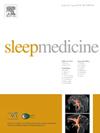Resting-state brain change on treatment improvement in insomnia disorder: A coordinate-based meta-analysis
IF 3.4
2区 医学
Q1 CLINICAL NEUROLOGY
引用次数: 0
Abstract
Many people suffer from insomnia worldwide, but we know little about the neuroimaging mechanisms of treatment improvement of insomnia disorder. This study aimed to investigate resting-state brain changes on treatment improvement in insomnia disorder. We searched Pubmed, web of science, and PsycINFO databases and finalized 14 studies, which reported changes in brain activity or functional connectivity in insomnia patients after treatment. Using activation likelihood estimation found that insomnia patients showed significant convergence in the superior frontal gyrus (SFG) after effective intervention. Behavioural decoding using the BrainMap database revealed that the SFG plays an important role in inhibition behavior, working memory (WM), reward emotion, and thermoregulation. Meta-analytic connectivity modelling analysis found that the SFG is shown to connect to several core nodes of the default mode network, including the middle frontal gyrus, precuneus, and cingulate gyrus. In conclusion, this study reveals the important role of SFG in the treatment of insomnia and provides a stable intervention target region for clinical intervention in insomnia.
静息状态脑改变对失眠障碍治疗改善的影响:基于坐标的meta分析
全世界有许多人患有失眠症,但我们对失眠症治疗改善的神经影像学机制知之甚少。本研究旨在探讨静息状态的大脑变化对失眠障碍治疗的改善。我们检索了Pubmed、web of science和PsycINFO数据库,并最终确定了14项研究,这些研究报告了失眠患者在治疗后大脑活动或功能连接的变化。激活似然估计发现,失眠患者在有效干预后,额上回(SFG)有显著收敛。使用BrainMap数据库的行为解码显示,SFG在抑制行为、工作记忆(WM)、奖励情绪和体温调节中发挥重要作用。元分析连通性模型分析发现,SFG连接到默认模式网络的几个核心节点,包括额叶中回、楔前叶和扣带回。综上所述,本研究揭示了SFG在治疗失眠中的重要作用,为临床干预失眠提供了一个稳定的干预靶区。
本文章由计算机程序翻译,如有差异,请以英文原文为准。
求助全文
约1分钟内获得全文
求助全文
来源期刊

Sleep medicine
医学-临床神经学
CiteScore
8.40
自引率
6.20%
发文量
1060
审稿时长
49 days
期刊介绍:
Sleep Medicine aims to be a journal no one involved in clinical sleep medicine can do without.
A journal primarily focussing on the human aspects of sleep, integrating the various disciplines that are involved in sleep medicine: neurology, clinical neurophysiology, internal medicine (particularly pulmonology and cardiology), psychology, psychiatry, sleep technology, pediatrics, neurosurgery, otorhinolaryngology, and dentistry.
The journal publishes the following types of articles: Reviews (also intended as a way to bridge the gap between basic sleep research and clinical relevance); Original Research Articles; Full-length articles; Brief communications; Controversies; Case reports; Letters to the Editor; Journal search and commentaries; Book reviews; Meeting announcements; Listing of relevant organisations plus web sites.
 求助内容:
求助内容: 应助结果提醒方式:
应助结果提醒方式:


